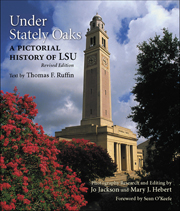
176 pages / 9.50 x 11.00 inches / 180 Halftones, 30 Color Illus., 3 Maps
History / United States - Southern History | LSU
In a captivating blend of photographs and text, Under Stately Oaks showcases over 150 years of Louisiana State University's past, following the evolution of the tiny Seminary of Learning of the State of Louisiana, founded near Pineville in 1853, into a university of well over 30,000 students for the twenty-first century. Thomas F. Ruffin has written an affectionate history of LSU, but it is also an honest one. The notorious scandals of 1939, the university's desegregation struggles, and free-speech alley confrontations during the civil rights movement and the Vietnam War, as well as the football team's 2003 NCAA championship and the university's pivotal role in relief efforts following Hurricane Katrina—all are chronicled here.
From the red pantile roofs and honey-colored stucco of its Italian Renaissance architecture to the "stately oaks and broad magnolias" hailed in the alma mater, the distinct beauty of the LSU campus is unrivaled. The history of the state's flagship university is as colorful as the azaleas that adorn its landscape every spring. Its first superintendent, William Tecumseh Sherman, later opposed its first faculty member and future president, David F. Boyd, in war. Yet both also fought for an LSU curriculum that embraced a liberal education with a classical component. When LSU lost its state funding during the 1870s, it was Boyd who maneuvered a merger with Louisiana A&M College, a move that ensured LSU's survival and preserved its identity. In the 1930s, Huey Long demanded the best for LSU on many fronts, and by the mid-twentieth century the institution was not only the state's premier university but also nationally recognized for its prestigious faculty and cutting-edge research.
This newly updated edition features a foreword by Chancellor Sean O'Keefe and a final chapter entitled "The 21st Century and Beyond," which details the concrete steps LSU has taken towards fulfilling its goal of becoming a nationally competitive flagship institution. The last chapter also portrays, in text and striking photographs, the central role LSU played in emergency relief efforts following Hurricane Katrina, and examines how the university is faring in the post-Katrina world.
Under Stately Oaks captures the spirit of the university as never before. Though the book shows that much has changed over the years, it is primarily a celebration of the timeless aspects of the LSU experience and a compelling testimony to the university's ongoing commitment to progress.
Found an Error? Tell us about it.